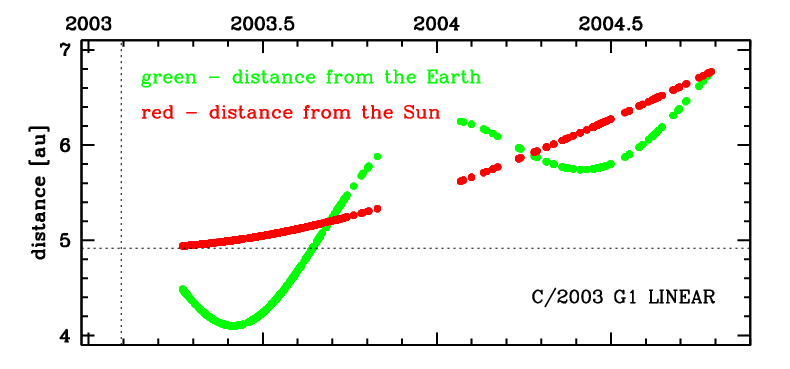C/2003 G1 LINEAR
more info
C/2003 G1 was discovered on 8 April 2003 by the LINEAR as an apparently asteroidal object. In the next two days its cometary apperance was reported by many observers [IAUC 8115, 2003 April 10]. At the moment of discovery it was about 2 months after its perihelion passage.
This comet made its closest approach to the Earth on 31 May 2003 (4.103 au), almost four months after perihelion.
Solution given here is based on data spanning over 1.5 yr in a range of heliocentric distances from 4.94 au to 6.77 au.
This Oort spike comet suffers moderate planetary perturbations during its passage through the planetary system that lead to escape of the comet from the solar system on hiperbolic orbit (see future barycentric orbit).
See also Królikowska 2014 and Królikowska and Dybczyński 2017.
This comet made its closest approach to the Earth on 31 May 2003 (4.103 au), almost four months after perihelion.
Solution given here is based on data spanning over 1.5 yr in a range of heliocentric distances from 4.94 au to 6.77 au.
This Oort spike comet suffers moderate planetary perturbations during its passage through the planetary system that lead to escape of the comet from the solar system on hiperbolic orbit (see future barycentric orbit).
See also Królikowska 2014 and Królikowska and Dybczyński 2017.
| solution description | ||
|---|---|---|
| number of observations | 1484 | |
| data interval | 2003 04 08 – 2004 10 14 | |
| data type | observed only after perihelion (POST) | |
| data arc selection | entire data set (STD) | |
| range of heliocentric distances | 4.94 au – 6.77au | |
| detectability of NG effects in the comet's motion | NG effects not determinable | |
| type of model of motion | GR - gravitational orbit | |
| data weighting | YES | |
| number of residuals | 2939 | |
| RMS [arcseconds] | 0.54 | |
| orbit quality class | 1a | |
| next orbit statistics, both Galactic and stellar perturbations were taken into account | ||
|---|---|---|
| no. of returning VCs in the swarm | 0 | |
| no. of escaping VCs in the swarm | 5001 | |
| no. of hyperbolas among escaping VCs in the swarm | 5001 | * |
| next reciprocal semi-major axis [10-6 au-1] | -373.43 – -372.62 – -371.80 | |
| next perihelion distance [au] | 5.5941 – 5.5977 – 5.6013 | |
| synchronous stop epoch [Myr] | 0.914 | S |
| percentage of VCs with qnext < 10 | 100 | |
| next_g orbit statistics, here only the Galactic tide has been included | ||
|---|---|---|
| no. of returning VCs in the swarm | 0 | |
| no. of escaping VCs in the swarm | 5001 | |
| no. of hyperbolas among escaping VCs in the swarm | 5001 | * |
| next reciprocal semi-major axis [10-6 au-1] | -373.51 – -372.70 – -371.88 | |
| next perihelion distance [au] | 5.7475 – 5.7518 – 5.7562 | |
| synchronous stop epoch [Myr] | 0.932 | S |
| percentage of VCs with qnext < 10 | 100 | |
